You know, history has these moments where one discovery changes everything. Well, the Bronze was one of them. People figured out that mixing copper with tin made bronze, and suddenly, things got a whole lot better. Stronger tools, sharper weapons, and smarter farming followed.
The thing is, bronze wasn’t just about survival, it pushed people to build, trade, and connect. Cities started growing, and cultures got more advanced.
The thing is, bronze wasn’t just about survival, it pushed people to build, trade, and connect. Cities started growing, and cultures got more advanced.
In this article
The Bronze Age Timeline
Well, the Bronze Age didn’t start at the same time everywhere, but generally, it lasted from around 3300 BCE to 1200 BCE. It came right after the Stone Age and set the stage for the Iron Age.
During this time, bronze tools and weapons became common, cities grew bigger, and trade spread across regions. It was the era when small communities started shaping the world.
Let’s take a detailed look at the Bronze Age timeline and explore how bronze changed the ancient world.
3300 BC: Mesopotamia (Sumer & Elam)
Mesopotamia, yep, this is the place where it all began. People here figured out that mixing copper with tin or arsenic made bronze. It was harder, sharper, and way more useful.
This little trick changed everything. Farmers got stronger plows. Soldiers carried better weapons. Trade took off. Cities grew. Even writing started around this time. Bronze wasn’t just metal. It was the engine that turned villages into civilizations.
3100-3000 BC: Egypt (Early Dynastic Period)
Egypt loved copper, but bronze started creeping in. At first, it was rare, used mostly by pharaohs and elite craftsmen. Owning bronze meant wealth, power, and status.
Slowly, it spread wider. Builders used bronze chisels to carve temples. Soldiers fought with bronze-tipped spears. By the Middle Kingdom, bronze was everywhere. Egypt’s rise as a mighty empire was powered, in part, by this strong and shining metal.
3000-2500 BC: Iran & Anatolia
In Iran and Anatolia, people didn’t wait for bronze to arrive. They made it themselves. Tools, weapons, and jewelry were crafted with skill and care.
These places became important trading hubs. Everyone wanted bronze, and they knew how to supply it. They might not get as much fame as Egypt or Mesopotamia, but their work shaped the Bronze Age in big, lasting ways.
2600-1900 BC: Indus Valley Civilization
The Indus Valley did things differently. Cities like Mohenjo-Daro and Harappa had neat streets and drains. Bronze here wasn’t about war. It was about everyday life.
People made mirrors, needles, farming tools, and even toys. They weren’t chasing conquest. They wanted order, peace, and planning. Bronze helped them build advanced, clean, and well-organized cities that thrived without chaos. That was their real strength.
2500-1200 BC: Levant & Canaan (Syria, Palestine, Jordan)
The Levant was buzzing with life. It sat at the crossroads of the ancient world, where traders, farmers, and warriors all relied on bronze.
Farmers plowed with bronze tools. Soldiers fought with bronze swords. Traders carried bronze goods from city to city. Through centuries of change, one thing stayed steady. Bronze kept farming, building, and battling possible. It powered survival and progress in this busy region.
2200-1600 BC: Minoan Crete (Aegean)
The Minoans lived on Crete, surrounded by sea and beauty. They weren’t focused on war. They cared about art, trade, and color. Bronze fit right into their world.
They used bronze for tools, ornaments, and even palace decorations. Their murals showed lively scenes, not battles. Bronze wasn’t about power here. It was about creativity and growth. For the Minoans, life was about thriving with style.
2300-1600 BC: Central Europe (Unetice Culture)
Central Europe didn’t have big temples or writing yet, but they had bronze. They shaped it into axes, jewelry, and useful tools. Their skill was quiet but impressive.
Leaders were buried with bronze treasures. These weren’t just shiny objects. They were symbols of power and respect. Without words, they told stories through metal. Bronze gave this culture a voice long before writing ever did.
2000 BC: Britain & Ireland (Beaker Culture)
Bronze finally reached the British Isles with the Beaker people. They brought new pottery styles, customs, and shiny bronze tools. Stone was out. Bronze was in.
Farming improved. Hunting was easier. Tools lasted longer. Jewelry added style. Communities grew stronger and more connected. Bronze didn’t just change daily life. It opened a whole new chapter for Britain and Ireland. A chapter shaped in metal.
1900-1500 BC: China (Erlitou Culture)
In China, the Erlitou culture took bronze to a new level. They made not just tools, but sacred objects for rituals. Bronze here carried deep meaning.
It showed power, respect for ancestors, and spiritual connection. These objects were carefully crafted, not just for use, but for belief. Erlitou bronze set the stage for future dynasties. It was the beginning of something much bigger in China’s story.
1600-1046 BC: China (Shang Dynasty)
The Shang Dynasty turned bronze into pure brilliance. They built giant foundries and made detailed vessels that still amaze us today. This was bronze at its peak.
They used it for war, rituals, and royal ceremonies. Chariots, weapons, bells were all made of bronze. If you had bronze, you had power. The Shang used it to rule, to worship, and to leave a mark that still shines.
1650-1100 BC: Mycenaean Greece
Mycenaean Greece was full of power and drama. Fortresses, warriors, and legends filled this world. Bronze fueled it all; swords, shields, and armor for heroes we still talk about today.
But it wasn’t just fighting. They built palaces, tombs, and treasures that inspired myths. Stories like Troy and Achilles echo this time. Their bronze wasn’t just metal. It was a legend, shaping history and memory.
1500-1200 BC: Western & Northern Europe
Bronze finally reached Europe’s far north and west. People there used it for swords, pins, tools, and farming gear. Life got easier, and communities grew stronger.
But bronze wasn’t just practical. Some items ended up in graves, lakes, and bogs. Offerings or rituals, we can’t be sure. They didn’t write stories, but their metalwork spoke loudly. Bronze shaped both daily life and mystery.
1200-1000 BC: Bronze Age Collapse
Then came the crash. Cities burned. Empires fell. Trade routes vanished. The Mycenaeans, Hittites, and more disappeared almost overnight. The Bronze Age was ending fast.
Why did it happen? No one knows for sure. Maybe war, famine, drought, or all of them at once. Whatever the cause, it closed one era. From the ruins, a new one rose, the Iron Age.
1000 BC: Korea
Korea’s Bronze Age started quietly. Bronze arrived from China, first in small amounts. But even that was enough to spark change. Tools, weapons, and ornaments took shape.
Burial sites show careful bronze work placed with meaning. Bronze wasn’t just handy. It marked respect, belief, and community. For Korea, this wasn’t an ending. It was the first page of a whole new chapter.
How to Make the Bronze Age Timeline Using EdrawMax?
So much happened during the Bronze Age, and a timeline is the best way to see it all at once. Luckily, you don’t need to be a designer to make one. EdrawMax gives you ready-made templates and smart tools that help you lay out history in a way that looks professional and easy to understand.
Here’s how to make your own Bronze Age timeline with EdrawMax:
Step1Start with a Blank Canvas
- Open EdrawMax on your desktop and sign in (or create an account if you’re new).
- Click New on the left panel, then choose Blank Drawing to get a fresh canvas for your Bronze Age timeline.

Step2Add a Background
- Go to the Insert tab and select Picture.
- Click Local Pictures to upload a background that reflects the Bronze Age.
- Adjust brightness, contrast, or transparency using the Adjust option on the toolbar that appears.
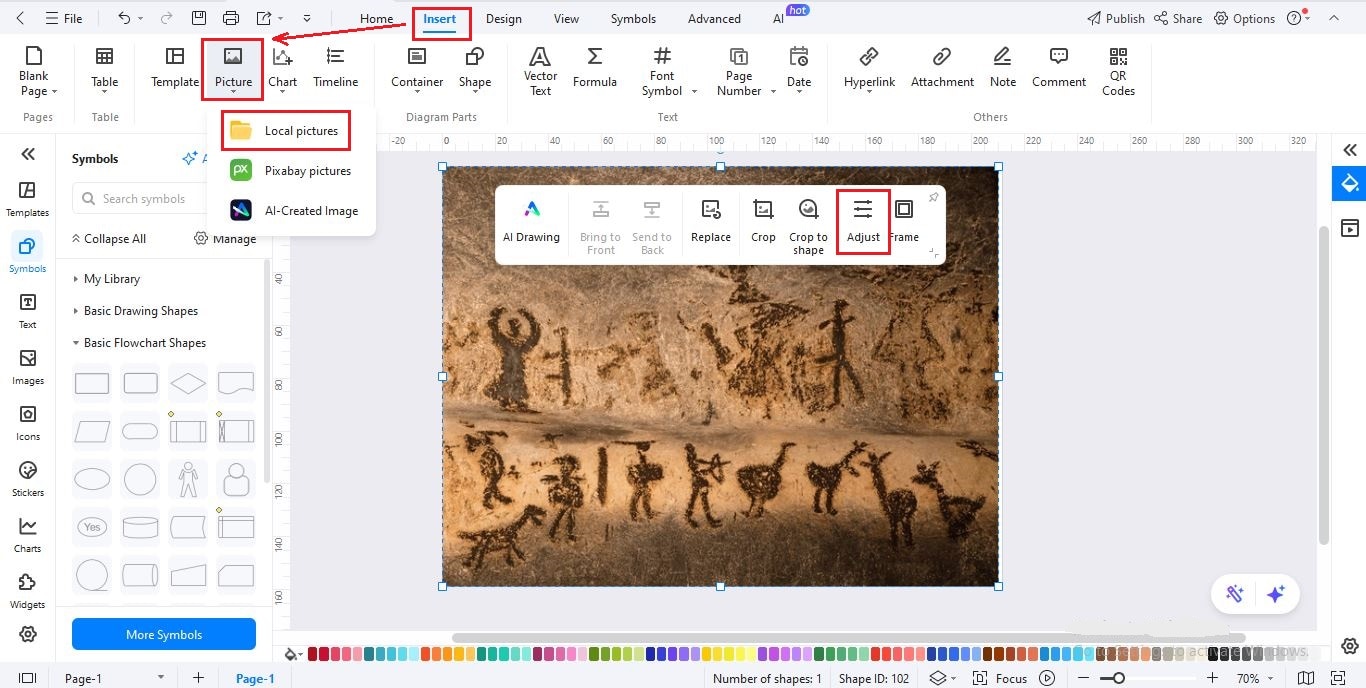
Step3Insert a Timeline Title
- Add a title to your timeline using a text box or image. For example, “The Bronze Age Timeline.”
- Click Insert > Picture > Local Pictures to add an illustrated title, or use a text box for a simple heading.
- Optionally, add Icons or small symbols, like bronze tools or pottery, to make the timeline more engaging.
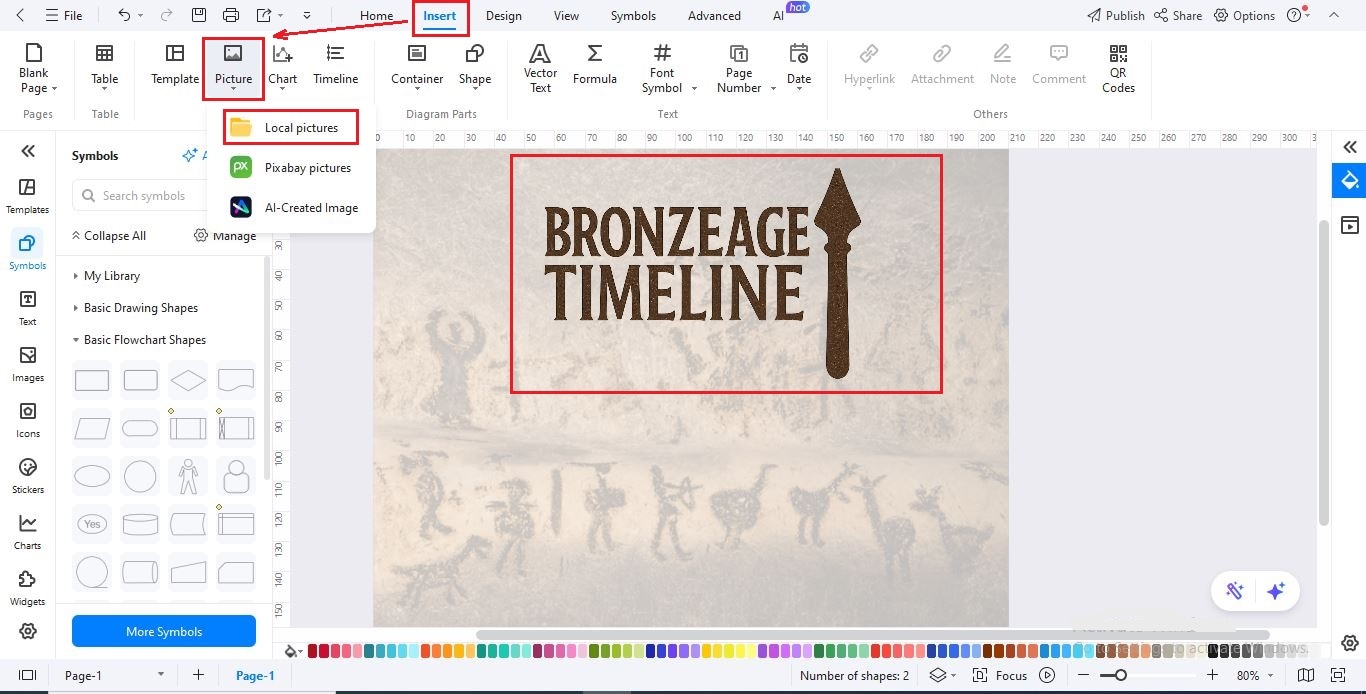
Step4Insert the Timeline Layout
- On the top menu, click Insert and choose Timeline.
- Select a Vertical Timeline with image placeholders, then click OK to add it to your canvas.
- Click the timeline to open a toolbar where you can adjust its structure to match the Bronze Age chronology.
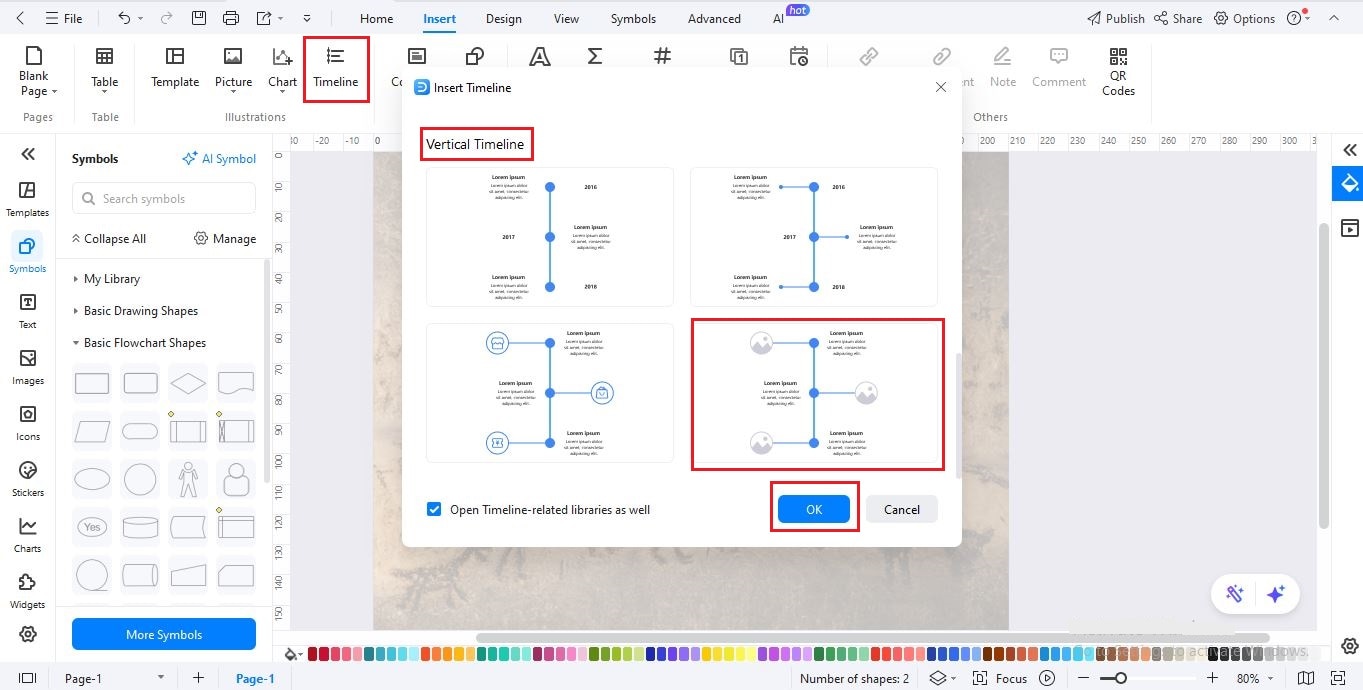
Step5Add Key Bronze Age Events
- Click Text on the left editing panel.
- Use Click to Add Subtitle for each date or period (e.g., 3300-1200 BCE).
- Use Click to Add Body to write a short description of each milestone.
- Repeat this for all major events.
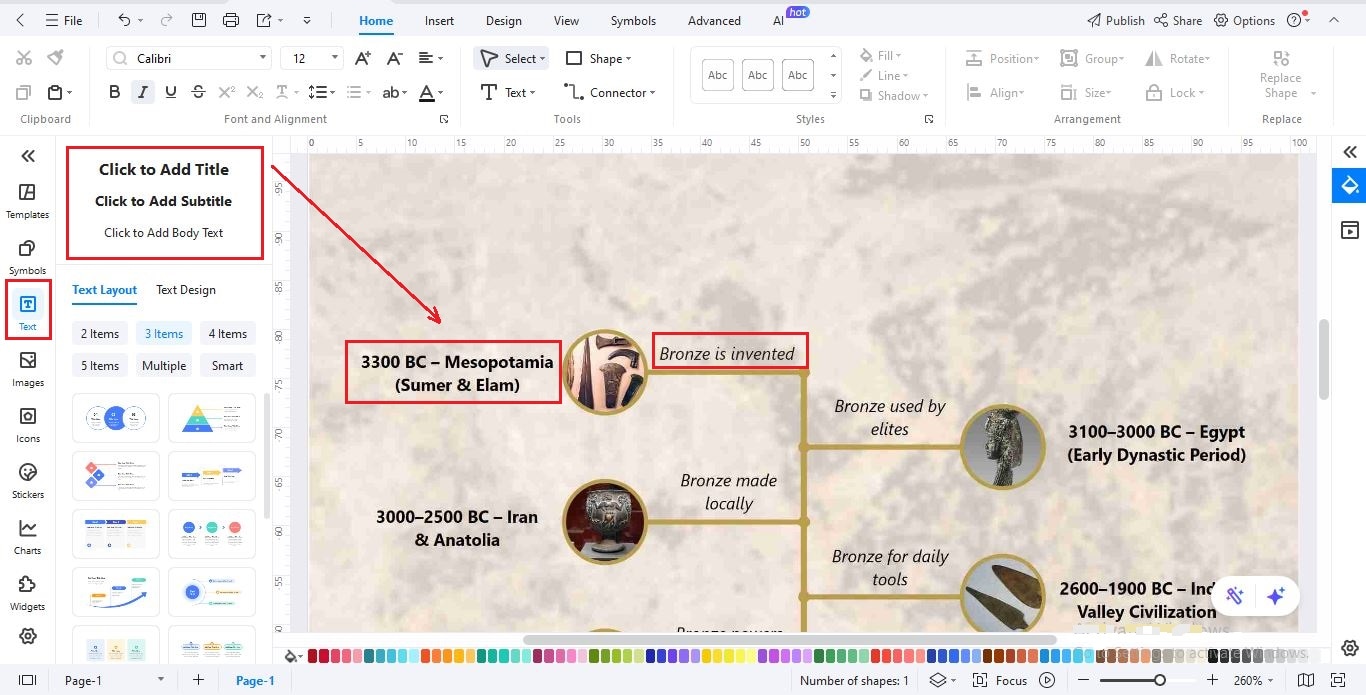
Step6Insert Milestone Images
- Go to Insert > Picture > Local Pictures and upload relevant images, like bronze tools, weapons, pottery, or ancient maps.
- Click on an image, choose Crop to Shape, and select a frame style.
- Repeat this for all key events to visually enrich your timeline.

Step7Save and Share Your Timeline
- Once your timeline is complete, click File > Save to keep an editable copy.
- To share, click File > Export and choose from PNG, PDF, SVG, HTML, Visio, or Excel formats.
- To showcase your work online, hit Publish to share with the EdrawMax community.
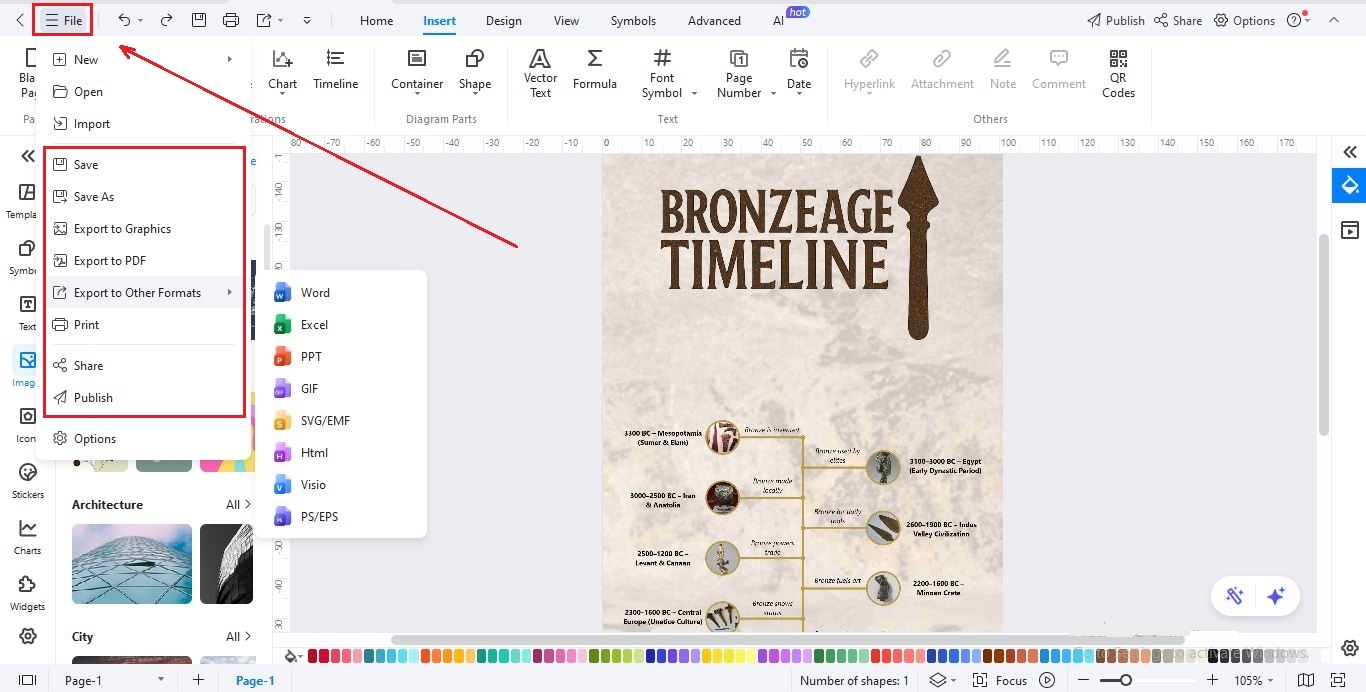
Closing Thoughts
The Bronze Age shows us how a simple alloy reshaped human life. With bronze, people built cities, traded across lands, and created art that still inspires today. Even after the age ended, its influence lived on.
If you’d like to explore more timelines like this or even make your own, try EdrawMax. It’s the easiest way to design clear timelines, organize history, and bring big stories to life with visuals.





